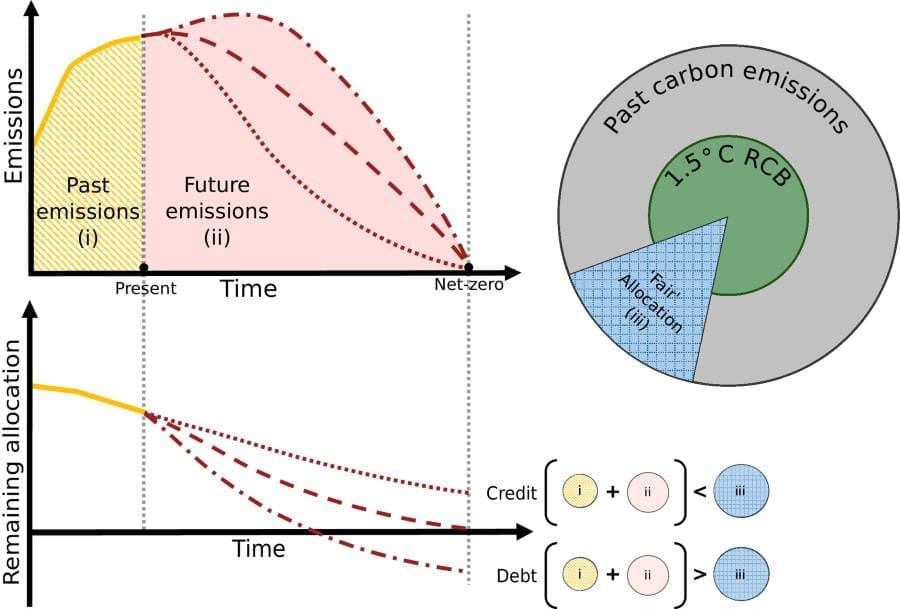Summary:
As the world moves closer to exceeding the Paris Agreement’s 1.5°C warming limit, a key question arises: who should take responsibility for the climate overshoot?
A new study published in Proceedings of the National Academy of Sciences introduces the concept of ‘net-zero carbon debt’ to assess which regions have contributed the most to the climate overshoot and what they should do to address it. Researchers from International Institute for Applied Systems Analysis (IIASA) and partner institutions analyzed historical and projected CO2 emissions to determine where carbon debt is accumulating.
Their findings show that some regions, due to past inaction or delays in reaching net-zero targets, will need to compensate by removing additional carbon or supporting emissions reductions elsewhere. The study calls for a transparent and equitable system to manage climate overshoot, ensuring that future generations are not left to deal with the consequences of today’s excess emissions.

Tracking net-zero carbon debt: who is responsible for overshoot of the 1.5°C climate limit?
Research shows that we are on course to exceed the Paris Agreement’s 1.5°C limit within a decade, exacerbating already heated international climate negotiations – some countries have achieved their wealth by polluting for decades and others argue for the same space to escape poverty and develop. Navigating this new context demands a transparent system that accounts for both historical and future emissions, ensuring each region shoulders its fair share of responsibility for climate action.
To inform efforts toward minimizing the magnitude and duration of the overshoot, in a new study, IIASA researchers explored the concept of a net-zero carbon debt. Using this measure, researchers can track which regions bear greater responsibility for the climate overshoot as it progresses, while explicitly accounting for past inaction. If a region is expected to accumulate net-zero carbon debt, it will need to compensate — either by supporting emissions reductions elsewhere in the world or by removing additional carbon from the atmosphere.
“As we near the Paris Agreement’s 1.5°C limit, the question is not just about when we will exceed it, but also how we collectively deal with the consequences in the subsequent period,” says Setu Pelz, lead author of the study and a researcher in the Transformative Institutional and Social Solutions Research Group of the IIASA Energy, Climate, and Environment Program. “To guide efforts that minimize overshoot and establish who should pay for harms caused during this period, we measure who is responsible and to what extent under a range of scenarios and approaches.”
Calculating a region’s net-zero carbon debt involves comparing historical and projected CO2 emissions in a region to its fair share of the remaining carbon budget for staying below 1.5°C. Any excess emissions by the time it reaches net-zero CO2 count as its carbon debt.
Applying this approach to deep mitigation scenarios assessed in the IPCC’s Sixth Assessment Report reveals distinct regional patterns. Some regions consistently accumulate debt due to past inaction, others accumulate debt depending on the timing of their net-zero CO2 targets this century, and some only if they delay net-zero CO2 beyond 2100.
To highlight the implications of carbon debt accumulation, authors of the study assessed carbon drawdown obligations and changes in lifetime exposure to extreme heatwaves under current global climate ambitions. Results show that every ton of net-zero carbon debt will not only increase the burden of emission reduction (and removal) on younger generations, but also worsen the climate impacts they will have to endure due to their region’s excess emissions.
Researchers argue that using the net-zero carbon debt measure alongside considerations of domestic feasibility, can help coordinate collective cost-effective efforts. They stress that regions expected to accumulate large carbon debts should strengthen sectoral mitigation plans, establish international support mechanisms to fund sustainable mitigation activities, and set clear targets for permanent carbon removal. Meanwhile, other regions should distinguish between cost-neutral domestic measures and those requiring international cooperation and climate finance.
***
This study is the result of cooperation between the scientists from IIASA, Climate Analytics, Humboldt University of Berlin, Imperial College London, Potsdam Institute for Climate Impact Research, and Vrije Universiteit Brussel.
Journal Reference:
Pelz, S., Ganti, G., Lamboll, R., Grant, L., Smith, C., Pachauri, S., Rogelj, J., Riahi, K., Thiery, W., Gidden, M., ‘Using net-zero carbon debt to track climate overshoot responsibility’, Proceedings of the National Academy of Sciences 122 (13) e2409316122 (2025). DOI: 10.1073/pnas.2409316122
Article Source:
Press Release/Material by Vladimir Tarakanov | IIASA
Featured image credit: Matthias Heyde | Unsplash




